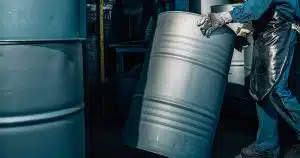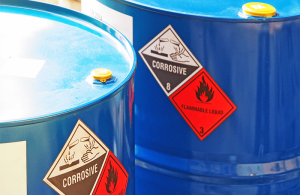Handling chemical and hazardous waste materials requires strict adherence to safety standards and federal regulations. From selecting the right container to ensuring proper labeling, every step in the process helps protect workers, facilities, and the environment from potential harm. Chemical and hazardous waste drums play a critical role in safely storing and transporting dangerous substances, but the details matter—especially when it comes to compliance with the Environmental Protection Agency (EPA) and the Department of Transportation (DOT).
This guide explores everything you need to know about storing, transporting, and managing chemical and hazardous waste drums, including EPA rules for empty containers, best practices for chemical drum storage, and proven methods for preventing leaks and spills during transport.
Gorilla Drum leads the industry with advanced, compliant containment solutions, including collapsible and reusable drum systems that meet or exceed UN and DOT safety standards.
Understanding the Role of Chemical and Hazardous Waste Drums
Hazmat drums are designed to safely store and transport chemicals, industrial waste, and other potentially dangerous materials. A 55 gallon hazmat drum is one of the most commonly used containers across industries such as manufacturing, environmental cleanup, and waste management.
Each drum is engineered to contain specific material types—liquids, solids, or sludges—under controlled conditions. They prevent leaks, resist corrosion, and maintain structural integrity during handling, storage, and transit.
Proper drum selection depends on the material’s classification, compatibility, and regulatory requirements. UN rated hazmat drums and DOT approved hazmat containers ensure compliance with international and domestic transport laws, keeping facilities and personnel safe.
What Is the EPA Rule for Empty Drum?

Definition of an Empty Drum
According to the EPA, a drum or container that once held hazardous material is considered empty when:
-
All wastes have been removed using common practices such as pouring, pumping, or aspirating, leaving no more than one inch of residue at the bottom.
-
For containers less than or equal to 110 gallons in size, no more than 3% by weight of the total capacity remains.
-
For containers greater than 110 gallons, no more than 0.3% by weight remains.
If a container holds compressed gas, it is considered empty when the pressure inside equals atmospheric pressure.
Why This Rule Matters
Empty drums are still subject to strict handling requirements because residue from hazardous materials can remain inside. Even trace amounts can pose risks if not managed properly. Reusing or disposing of drums that are not officially deemed “empty” can result in environmental contamination, regulatory violations, or worker injury.
Facilities must document their drum-cleaning and disposal practices to demonstrate compliance during audits or inspections. Empty drums should be stored separately from filled ones and clearly marked to prevent accidental reuse.
Proper Handling and Reuse
Once a drum meets the EPA’s definition of “empty,” it can be recycled, reused, or sent for reconditioning. However, it must not be used for incompatible materials that could cause a reaction with the residue.
Many facilities choose to repurpose empty drums for non-hazardous applications, while others rely on specialized recycling programs to recover materials safely. For companies handling large volumes of drums, collapsible UN rated hazmat drums can reduce waste and simplify logistics, offering a safer, more sustainable alternative.
What Is the Proper Way to Store Chemical Waste?

Use the Right Containers
Only containers specifically designed for hazardous materials should be used for chemical drum storage. A 55 gallon hazmat drum is ideal for large quantities, while smaller containers may be better for laboratory or specialty waste.
Drums should be UN and DOT certified to ensure that they meet performance standards for leakproofness, impact resistance, and pressure containment. Containers must also be compatible with the waste they store—metal drums for flammable liquids, polyethylene drums for corrosive chemicals, and composite drums for mixed waste types.
Labeling and Identification
Each hazardous waste drum must be clearly labeled with:
-
The words “Hazardous Waste”
-
The accumulation start date
-
A description of the contents
-
The generator’s name and contact information
These labels ensure traceability and compliance during storage, transport, and disposal. Faded or missing labels can lead to regulatory violations or unsafe handling.
Segregate Waste Types
Never mix incompatible chemicals in the same storage area. Keep acids away from bases, oxidizers separate from flammables, and reactive substances isolated. Proper segregation minimizes the risk of fires, explosions, or chemical reactions.
Secondary containment systems, such as spill pallets or berms, should be used under all hazardous waste drums to catch leaks or overflows.
Maintain Safe Storage Conditions
Temperature, ventilation, and humidity levels play a major role in chemical stability. Drums should be stored in cool, dry, and well-ventilated spaces away from direct sunlight or ignition sources.
Proper stacking and spacing also prevent accidents. Avoid stacking more than two drums high unless the containers are designed for stacking and the floor is reinforced to bear the load.
Regular Inspection and Maintenance
Inspect hazmat storage drums weekly for signs of leaks, corrosion, or damage. Any drum showing structural issues should be repaired or replaced immediately. Recordkeeping is essential—maintain inspection logs to demonstrate compliance and identify recurring issues.
Spill Preparedness
Even the most careful facilities must be prepared for accidental releases. Keep spill containment kits, absorbent pads, and neutralizing agents near drum storage areas. Workers should receive training in spill response procedures, including containment, cleanup, and reporting requirements.
Storage Duration
The EPA regulates how long hazardous waste can be stored on-site before it must be shipped to a disposal or treatment facility. The limit typically ranges from 90 to 180 days depending on generator size. Drums exceeding this timeframe can trigger fines or enforcement actions.
Choosing the Right Drum
Proper waste storage begins with selecting the right drum for the material type. To help facilities make informed decisions, Gorilla Drum offers a comprehensive resource: the Guide To Choosing The Right Hazmat Drums For Waste Storage. This guide explains container materials, certifications, and compatibility requirements to ensure compliance and safety.
How Do You Prevent Leaks and Spills During Drum Transport?
Choose the Right Container
UN rated hazmat drums and DOT approved hazmat containers are designed for transport. These drums are tested under rigorous conditions, including drop, vibration, and pressure testing, to ensure they can withstand the stresses of shipping.
A 55 gallon drum for hazardous waste must display the correct UN markings, indicating that it meets all performance and compatibility standards for the materials inside. Drums should also have secure, leakproof closures such as bolted rings or sealed lids.
Inspect Drums Before Loading
Before transport, inspect each drum for dents, leaks, corrosion, or loose fittings. Verify that all bungs, gaskets, and closures are properly tightened. A single compromised drum can cause contamination across an entire shipment.
Make sure labeling is visible and legible. Missing or damaged hazard labels can delay transport or cause regulatory violations.
Proper Loading Techniques
Drums should be loaded upright on pallets or containment platforms to prevent tipping. Secure them using ratchet straps, banding, or load bars to prevent movement during transit.
Distribute weight evenly across the vehicle to maintain balance and stability. Avoid stacking drums unless they are designed for that purpose and the carrier’s equipment supports vertical loads.
Secondary Containment During Transport
For added protection, use secondary containment systems such as overpacks, spill trays, or liners during shipping. These systems provide an extra layer of safety in case of leakage.
Transport vehicles should also carry absorbent materials and spill kits to manage potential releases en route.
Temperature and Environmental Control
Extreme temperatures can compromise drum integrity or cause materials to expand and contract. Whenever possible, transport drums in climate-controlled environments or shaded conditions. Avoid prolonged exposure to direct sunlight, which can degrade seals and increase internal pressure.
Compliance Documentation
Every shipment of hazardous waste or chemicals must include proper documentation, including:
-
Shipping papers identifying the material and hazard class
-
Emergency response contact information
-
UN identification numbers
-
Certification that containers meet DOT standards
Drivers and handlers must also be trained in hazardous materials transport regulations to ensure safe and compliant delivery.
Handling After Delivery
Once drums arrive at their destination, they should be carefully unloaded and inspected again for damage or leaks. Any residue on the exterior must be cleaned before storage or reuse.
Hazmat barrels should then be placed in designated chemical drum storage areas equipped with secondary containment and ventilation systems.
The Role of Modern Drum Design in Safety
Modern technology has revolutionized chemical and hazardous waste containment. Gorilla Drum’s collapsible containers combine strength, compliance, and convenience in a single solution.
Made from durable, chemical-resistant polypropylene, Gorilla Drums meet both UN and DOT standards while offering a lightweight, foldable design that saves up to 80% of storage space when empty.
These drums are ideal for handling liquids, solids, or mixed waste materials. Their reinforced structure supports vertical stacking, while the double-zippered closure ensures leak-tight performance even during transport.
By eliminating the need for heavy steel drums and reducing waste, collapsible hazmat drums enhance operational efficiency while maintaining the highest safety standards.
Environmental and Sustainability Benefits
Using reusable and recyclable hazmat storage drums significantly reduces waste generation and disposal costs. Each Gorilla Drum is designed for multiple uses, helping facilities reduce their environmental footprint and comply with sustainability initiatives.
Because these drums can be reused, they minimize the production and disposal of single-use containers. They also cut down on shipping costs and emissions by allowing more units per load due to their collapsible nature.
Sustainability and compliance go hand in hand—Gorilla Drum helps businesses achieve both through innovation and responsible design.
Common Applications for Hazmat Drums
-
Chemical manufacturing and processing
-
Environmental cleanup and waste remediation
-
Pharmaceutical and laboratory waste management
-
Oil and fuel containment
-
Paints, solvents, and coatings storage
-
Food and beverage ingredient handling (non-hazardous materials)
-
Industrial waste recycling and transport
These industries rely on certified hazardous waste drums and chemical barrels to ensure safe, compliant operations.
Gorilla Drum: Setting a Higher Standard in Chemical Safety
Gorilla Drum has reimagined the way facilities handle hazardous materials. Unlike conventional rigid drums, Gorilla Drum’s collapsible design provides unmatched versatility, space efficiency, and cost savings without compromising safety or performance.
Each unit is tested and certified as a UN rated hazmat drum and DOT approved hazmat container, ensuring full compliance for domestic and international transport. Whether used for chemical storage, waste collection, or environmental cleanup, Gorilla Drum’s innovative design simplifies every step of the process.
Final Thoughts
Safe storage and transport of chemical and waste drums require the right equipment, proper training, and strict compliance with EPA and DOT regulations. By using certified containers, implementing strong storage practices, and following preventive measures during transport, facilities can minimize risks and maintain operational integrity.
Gorilla Drum provides a reliable, compliant, and sustainable solution for chemical and hazardous waste containment. Built to handle liquids, solids, and sludges, Gorilla Drum offers superior performance while reducing storage and shipping costs.
To learn more about safe storage and transport solutions for hazardous materials, call +1 800-758-8079.


 Transporting hazardous materials presents unique challenges, especially when dealing with liquids or reactive substances. Spills during transit can lead to environmental damage, regulatory penalties, and costly cleanup efforts. Following best practices and using compliant equipment greatly reduces the risk. Every stage of transport—from loading to unloading—must be planned carefully to ensure stability and containment. Proper training for drivers and handlers, clear labeling, and the use of UN rated hazmat drums or DOT approved hazmat containers help maintain compliance and safety throughout the entire journey. In addition, ongoing inspection and maintenance of vehicles, secure strapping methods, and real-time monitoring systems can further prevent incidents and ensure that materials arrive safely at their destination every time.
Transporting hazardous materials presents unique challenges, especially when dealing with liquids or reactive substances. Spills during transit can lead to environmental damage, regulatory penalties, and costly cleanup efforts. Following best practices and using compliant equipment greatly reduces the risk. Every stage of transport—from loading to unloading—must be planned carefully to ensure stability and containment. Proper training for drivers and handlers, clear labeling, and the use of UN rated hazmat drums or DOT approved hazmat containers help maintain compliance and safety throughout the entire journey. In addition, ongoing inspection and maintenance of vehicles, secure strapping methods, and real-time monitoring systems can further prevent incidents and ensure that materials arrive safely at their destination every time.